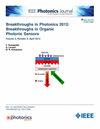SBS Suppression Capability of Optimized Pseudo-Random Binary Sequence Phase Modulation in Multi-Stage Fiber Amplifiers
IF 2.4
4区 工程技术
Q3 ENGINEERING, ELECTRICAL & ELECTRONIC
引用次数: 0
Abstract
We demonstrate the capability to suppress stimulated Brillouin scattering (SBS) in a high-power all-fiber laser amplifier system using filtered and amplified pseudo-random binary sequence (PRBS) phase modulation techniques. Based on the time-dependent three-wave coupled SBS interaction equations in an amplifier model consisting of active fiber and passive fiber and spectral calculation of phase modulation, we numerically simulate the dependence of the normalized SBS threshold and the root-mean-square (RMS) linewidth on both the filter cutoff frequency and the phase modulation depth for filtered and amplified PRBS phase modulation at a fixed clock rate with different pattern lengths. PRBS9 is superior to other investigated patterns. A set of optimal pattern lengths, RMS modulation depths, and the ratio of the filter cutoff frequency to the clock rate are determined. Specific time-domain details of the variation of the RF signal with experimentally measured RMS modulation depth are shown. The dependence of different time-domain waveforms and their corresponding spectra and SBS thresholds on the RMS modulation depth is illustrated by theoretical predictions and experimental measurements, and the optimal value of the RMS modulation depth is demonstrated. Then, both the RMS linewidth of the optical spectra and the maximum normalized SBS threshold under the optimized parameters increase linearly with clock rate. While, with the further increase of the clock rate to ∼14 GHz, the SBS threshold reaches a saturation point when the maximum effective spectral linewidth is reached, where the spectral line spacing is half of the FWHM Brillouin linewidth, and the optimal spectral line spacing is not affected by the fiber length of the system. Eventually, a laser power output of 2.78 kW at an FWHM linewidth of 9.95 GHz is experimentally obtained.多级光纤放大器中优化伪随机二值序列相位调制的SBS抑制性能
我们展示了在高功率全光纤激光放大系统中使用滤波和放大伪随机二进制序列相位调制技术抑制受激布里渊散射(SBS)的能力。基于有源光纤和无源光纤放大器模型中随时间变化的三波耦合SBS相互作用方程和相位调制的频谱计算,数值模拟了在不同方向图长度的固定时钟速率下,滤波和放大PRBS相位调制时,归一化SBS阈值和RMS线宽对滤波器截止频率和相位调制深度的依赖关系。PRBS9优于其他已研究的模式。确定了一组最佳模式长度、RMS调制深度和滤波器截止频率与时钟速率的比率。给出了射频信号随实验测量的均方根调制深度变化的具体时域细节。通过理论预测和实验测量,说明了不同时域波形及其对应的谱和SBS阈值对RMS调制深度的依赖关系,并给出了RMS调制深度的最佳值。然后,在优化参数下,光谱的均方根线宽和最大归一化SBS阈值随时钟速率线性增加。而随着时钟速率进一步提高到~ 14 GHz, SBS阈值在达到最大有效谱线宽度时达到饱和点,此时谱线间距为FWHM布里频线宽度的一半,且最佳谱线间距不受系统光纤长度的影响。实验结果表明,在9.95 GHz频宽下,激光输出功率为2.78 kW。
本文章由计算机程序翻译,如有差异,请以英文原文为准。
求助全文
约1分钟内获得全文
求助全文
来源期刊

IEEE Photonics Journal
ENGINEERING, ELECTRICAL & ELECTRONIC-OPTICS
CiteScore
4.50
自引率
8.30%
发文量
489
审稿时长
1.4 months
期刊介绍:
Breakthroughs in the generation of light and in its control and utilization have given rise to the field of Photonics, a rapidly expanding area of science and technology with major technological and economic impact. Photonics integrates quantum electronics and optics to accelerate progress in the generation of novel photon sources and in their utilization in emerging applications at the micro and nano scales spanning from the far-infrared/THz to the x-ray region of the electromagnetic spectrum. IEEE Photonics Journal is an online-only journal dedicated to the rapid disclosure of top-quality peer-reviewed research at the forefront of all areas of photonics. Contributions addressing issues ranging from fundamental understanding to emerging technologies and applications are within the scope of the Journal. The Journal includes topics in: Photon sources from far infrared to X-rays, Photonics materials and engineered photonic structures, Integrated optics and optoelectronic, Ultrafast, attosecond, high field and short wavelength photonics, Biophotonics, including DNA photonics, Nanophotonics, Magnetophotonics, Fundamentals of light propagation and interaction; nonlinear effects, Optical data storage, Fiber optics and optical communications devices, systems, and technologies, Micro Opto Electro Mechanical Systems (MOEMS), Microwave photonics, Optical Sensors.
 求助内容:
求助内容: 应助结果提醒方式:
应助结果提醒方式:


